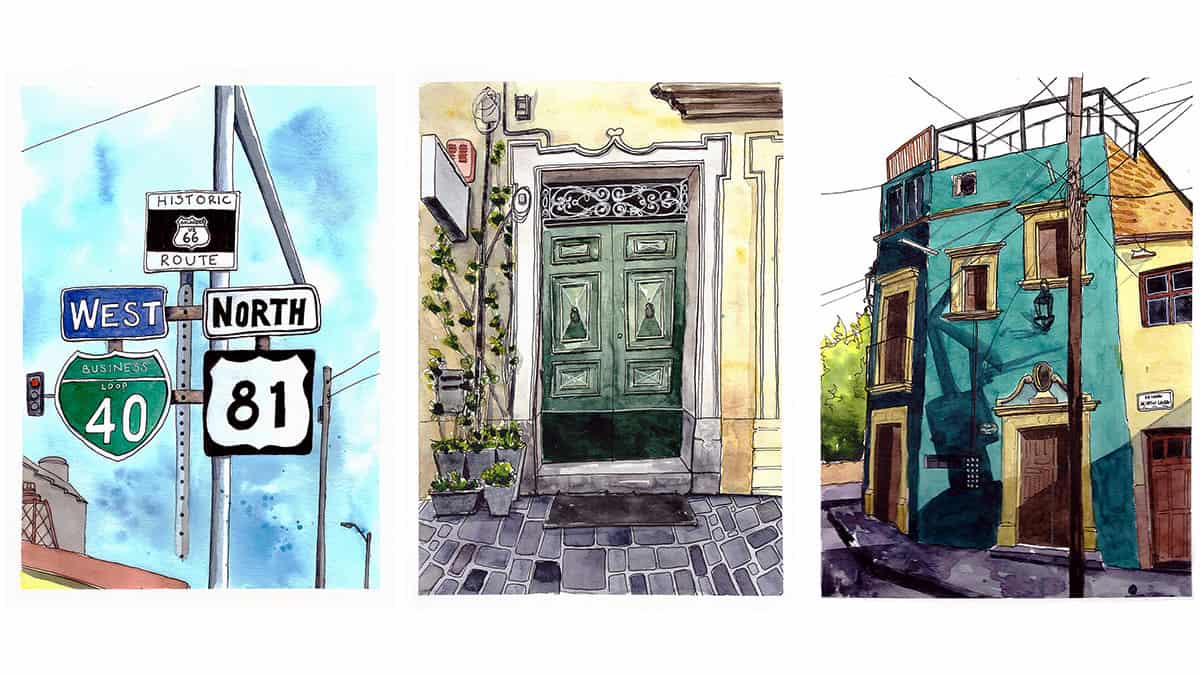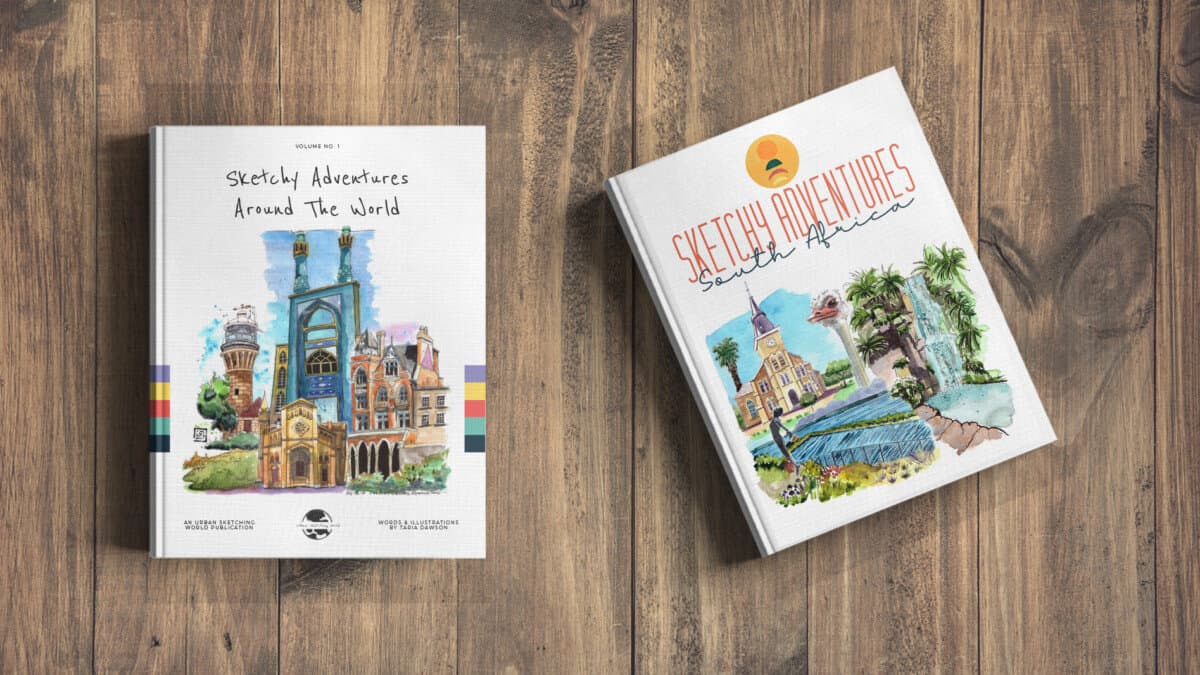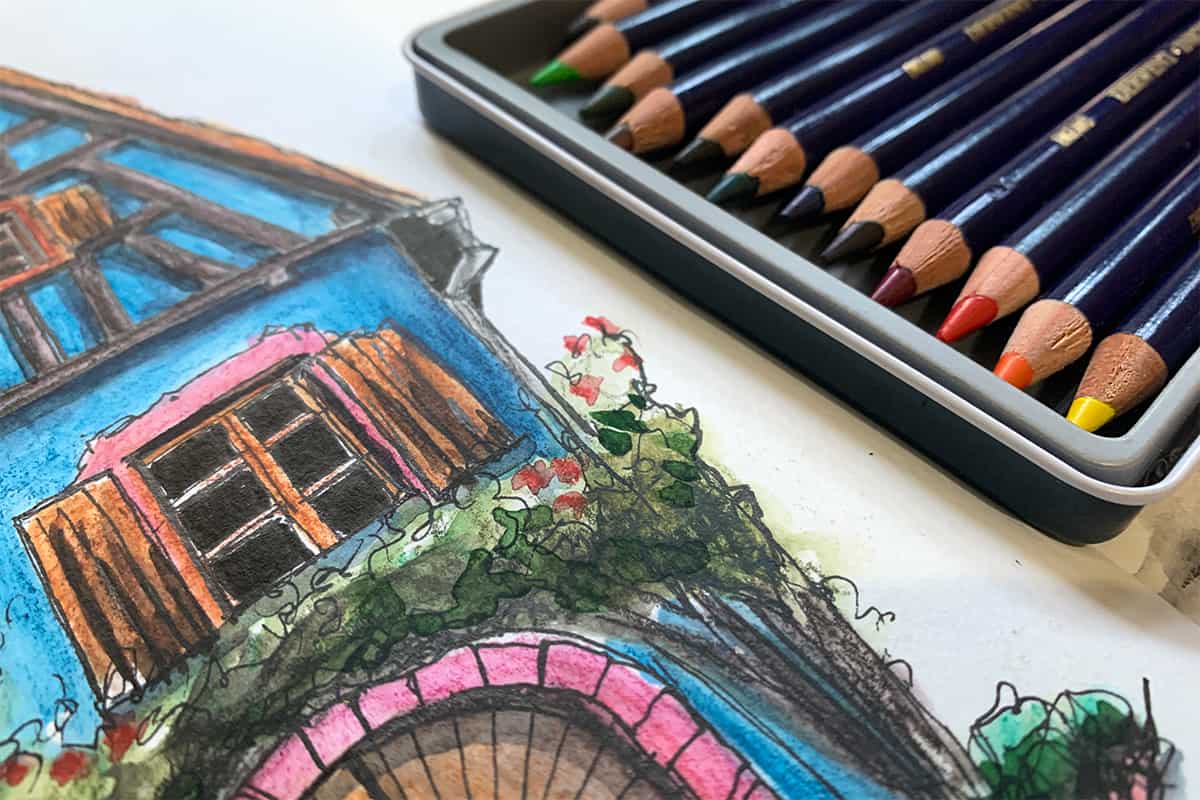It’s no secret that the vast majority of urban sketchers’ tool of choice is watercolour paint, however, it’s not that often I see or come across sketchers using watercolour pencils. In this post, we will delve into the mysterious world of watercolour pencils to discover what they’re all about and see if they could be a viable tool for urban sketchers too.
What are Watercolour Pencils?
Watercolour pencils are basically colour pencils but they have the added benefit that they are water-soluble, so they are multifunctional – you can use them as either colour pencils or watercolour paint…two tools in one!
Watercolour pencils are useful because when sharpened they can achieve fine details that you can’t really achieve with a brush. On the downside, you can’t quite achieve the effects you can with watercolour paint. But if you accept watercolour pencils are a medium in their own right then I think you will be pleasantly surprised by their versatility.
Will they replace watercolour paint as my main weapon of choice? No.
Are they super fun to experiment with? Oh, yes.
Benefits of Watercolour Pencils
- Can be used to draw and paint with
- Easy to transport
- They do not expire or ‘go bad’
- Blendable
- Affordable
- Layering and mixing
- Achieve fine delicate details
- Achieve textures
- Use them with watercolour paint
Do Any Urban Sketchers Use Watercolour Pencils
From my own personal knowledge of the urban sketching world, I know of very very few urban sketchers who use watercolour pencils. That’s not to say they’re not out there, I just have not really come across any on either my physical travels or virtual internet travels.
In the video below, urban sketcher Lynne Chapman, demonstrates an urban sketch from the window of a cafe out across the street with watercolour pencils. I wish Lynne had more videos like this, I loved watching her process.
Liz Steel certainly carries watercolour pencils in her urban sketching kit. While she doesn’t use them exclusively she definitely uses them alongside watercolour paint, possibly to pull out edges and add finer details with the sharpened point.
You can see the trailer for Liz’s Foundations course below:
James Gurney also carries watercolour pencils in his kit, as far as I can tell from watching a countless amount of his videos, he predominantly uses the to do his foundational basic sketch which he paints over.
Which Watercolour Pencils Should I Buy?
Derwent Watercolour
Derwent is a well-known British brand. They supply a variety of different types of pencils so you do actually need to pay attention to what you’re looking at. As I mentioned below, it totally escaped my attention that the Inktense watercolour pencil range is something different and in fact, there is a traditional watercolour pencil range too!
I have tried the ‘student’ quality range of watercolour pencils from Derwent (I think they’re labelled Academy) and just please don’t waste your money. They are wishy-washy and weak. I really did not enjoy my experience of using them and in fact, it entirely put me off trying out any other watercolour pencils for many years. Stick to the ‘professional’ quality range.
Funnily enough, the traditional watercolour pencils are the range that says ‘Watercolour’ on the front! Ha. Available from Amazon as well as your local art supplier.
Set of 12 | Set of 24 | Set of 36 | Set of 72
Derwent Inktense
I wasn’t really aware the ‘Inktense’ range from Derwent was a separate product and as such the ‘watercolour pencils’ I thought I had bought are in fact a bit different from traditional watercolour pencils.
Either way, I really like the Inktense watercolour pencils I have. It’s the set of 12 and they are super vibrant. If you are looking to create bright bold illustrations then out of all of the watercolour pencils, these are the ones. The pencils don’t have the traditional water-soluble pigment that other pencils do, they are actually made from some type of ink. As such you can use them on fabric as well as paper!
You find Derwent Inktense pencils on Amazon (as well as you local art store):
Set of 12 | Set of 24 | Set of 36 | Set of 72
Faber Castell Albrecht Durer
Faber Castell is a highly regarded brand and their series of Albrecht Durer watercolour pencils and markers have been very well received. There’s no doubt these pencils are professional quality. They’re about the same price point as the Derwent pencils (I suppose this depends on where you’re shopping though).
What I like about Faber Castell is that all of their products are completely colour matched, this means you can switch seamlessly between their markers or pencils (either standard of watercolour) and the colours will match.
These are absolutely excellent watercolour pencils that are highlight pigmented and that can achieve more realistic watercolour results than other pencils in this list so if you can afford some (or even find them cheaper than the Derwent sets) then go for it.
Set of 12 | Set of 36 | Set of 60
Spectrum Noir
Spectrum Noir has recently rebranded its product range and made them more concise. Their watercolour pencil range is now called ‘Aquablend’, makes sense. Spectrum Noir are certainly a brand aimed more at crafters than artists but their products still stand up and usually can be found at a more favourable price. I haven’t tried these pencils thoroughly.
My mum is a card maker and has the full set of these pencils, she’s used them for years and for her purposes they’re perfect. I’ve seen mixed reviews, mostly positive but with some negative.
Everyone seems to agree the pigments are nice and vivid but I think there have been some quality issues and perhaps they don’t lay down colour as smoothly as some of the options above. I’m not sure they would be my first choice.
Set of 24 – Primaries | Set of 24 – Naturals
I strongly advise staying away from cheaper ‘student’ quality brands. It can be such a shame when art supplies labelled as student quality are so severely not up to par. It can put people off using a medium for years, as happened to me. If you want to try watercolour pencils but don’t have much money to spare buy professional quality and a smaller pack, i.e. a set of 12. A lot of these pencils can be bought individually in art stores so you can always add to your collection at a later date, pencil by pencil if needs be. Buying student quality is just false economy.
Some of my favourite online classes
- Watercolor Travel Journal – Alicia Aradilla
- Expressive Architectural Sketching with Colored Markers – Albert Kiefer
- Artistic Watercolour Techniques For Illustrating Birds – Sarah Stokes
- Architectural Sketching with Watercolor and Ink – Alex Hillkurtz
Which Paper for Watercolour Pencils?
Firstly, the best paper to use is watercolour paper, that is if you intend to use water with pencils. If you use the pencils dry, without any water, then you can use any paper. If applying water, you need a paper that can handle wet media.
Watercolour pencils will behave differently on different textures of paper. If you use watercolour pencils on cold press paper which has some texture then you will find the pencil marks will be more apparent and you will end up with a grainer result. This is actually super useful if you are sketching architecture. The resulting textures form the pencils lend themselves well to achieving the rough texture of brick, stone and concrete.
If, however, you are looking for a super smooth textureless or flat wash of colour, then you would be better served using hot press i.e. smooth paper.
Techniques for Using Watercolour Pencils
Pressure
The amount of pressure you use on the pencil to lay down pigment will affect the intensity of your colour. If you colour lightly with the pencil then your colour will be less intense. In this way, you can colour heavily and then lighten as you move across an area to achieve a nice gradient when you come to apply water with a brush.
Pencil Strokes
It’s important to be aware of the direction of your pencil strokes, this is even more true if you are using textured paper. This is because the strokes will show through, even after applying water. So make sure your strokes match the direction of the texture of the subject you are sketching.
Water
It’s important to control how much water you apply when painting over your pencil strokes. Too much and the colour will be washed out, too little and you won’t get a smooth application. Practice is the only way to learn how much water to apply with your brush.
Want to learn travel sketching in ink & watercolour?
Check out my course, Sketch Your Adventures and for a limited time get 50% OFF!!!

Layering and Mixing
You can achieve different hues form you pencils by layering them, either directly over the top of one another or by colouring in more of a gradient. When you apply water you can blend from one colour to another or they can be mixed together to create a new colour.
Use Colour First & Then Applying Water
Mostly, I lay down an area of pencil strokes on a sketch and then ‘activate’ the colour by applying water with a brush. As mentioned above, controlling how much water you have on your brush will help you control the colour. Also, make sure your strokes are consistent and be aware of their direction as these will not completely disappear when you apply water. This should actually be used to your advantage so you can indicate texture.
Use Water & Then Apply Colour
Another way of using watercolour pencils is to apply the colour over a wet area and see what effects can be achieved.
Koosje from Sketchbook Skool demonstrates some of the techniques in the video below:
Taking Colour From The Pencil Nib
You can use a wet brush and pick up colour directly from the nib of the pencil. This leads to a more traditional watercolour effect, with lighter and less intense pigment as well as a smoother application as you will not have the pencil marks on the paper.
Using Paper as a Palette
Another technique you can use to apply watercolour pencils to your sketch is by using a piece of paper as a palette. Simply scribble your chosen colour on a piece of paper, take your brush with some water on it and lift off the pigment from the paper to then apply to your sketch. This also leads to a less intense pigment and achieves a more delicate watercolour effect.
Check out my ebooks with hundreds of ink & watercolour travel sketches from all over the world. Get some inspiration for your next trip…

Can You Use Watercolour Pencils for Urban Sketching?
My initial answer is, you can use anything for urban sketching! Anything goes! But let’s talk about practicality. Watercolour pencils are available to buy in most art shops, they are portable, they are certainly flexible – acting as both pencils and paint – they are reliable, they aren’t too fragile (but please don’t drop them), so I think all in all, yes they are perfectly good for urban sketching.
I find I have to work a little harder at getting a result I like when using watercolour pencils but I think this is just because of inexperience and actually if I keep practising with them I could get a consistent result I am happy with.
I can’t see that I would replace my paints with watercolour pencils but I would certainly carry them around as an additional tool and sometimes opt to use them instead of paints. I think they would be super handy in a setting where you are not allowed to use wet media, such as certain museums and art galleries. You could lay down the dry pencil marks and apply water later on for example.
In the video below I talk a bit more about urban sketching with watercolour pencils and do a little demo from reference of a door in Tuscany with the Derwent Inktense watercolour pencils.
Where to Learn More About Watercolour Pencils
Youtube
The Mind of Watercolor
Below is a great video of a demo sketch using Prismacolor watercolour pencils:
Chris Evans
I really like Chris Evans’ videos, in fact by watching one of his videos it really helped me break through some of my difficulties with painting a beach scene. In the video below, Chris discusses the versatility of watercolour pencils and how he uses them to record scenes in his sketchbook. He demonstrates some different techniques and concludes that a tin of 24 watercolour pencils is the maximum number of pencils you will ever need…don’t bother with the huge tins of 72!
If you want a super in depth review of 26 different brands of watercolour pencils (and by in depth we’re talking a video over 1.5 hours long) then check out the video below which could be super useful to help you figure out which brand you may want to try out:
Skillshare
Skillshare is an online learning platform where you can learn any skill imaginable, including how to use watercolour pencils!
These are my top picks of the courses on how to learn watercolour pencils:
Introduction to Watercolor Pencils
7 Ways to Use Watercolor Pencils
Watercolor Pencils Step By Step
If you would like a free trial sign up to Skillshare with this link.
Final Thoughts
I have learned a lot more about watercolours in writing this article and dedicating some solid time to learning how to use them. I’m inspired to carry on using my Derwent Inktense pencils and am tempted to expand my collection with a few more shades.
I think they’re a great tool for urban sketching. You can keep them as low key as you want by using them just as pencils and adding water back at home or you can carry your waterbrush around and still have a super minimalist kit. I’m all about the minimalism
Do you use watercolour pencils? I’d love to hear your thoughts or tips. You can drop me a comment on my youtube video on the topic which I included in this post above or you can message me on Instagram: @urbansketchingworld
If you love urban sketching and want to receive further inspiration, tutorials and behind the scenes info on my latest projects, join my newsletter! I only email once or twice a month, maximum. Pop your email in the box below to stay in touch.

